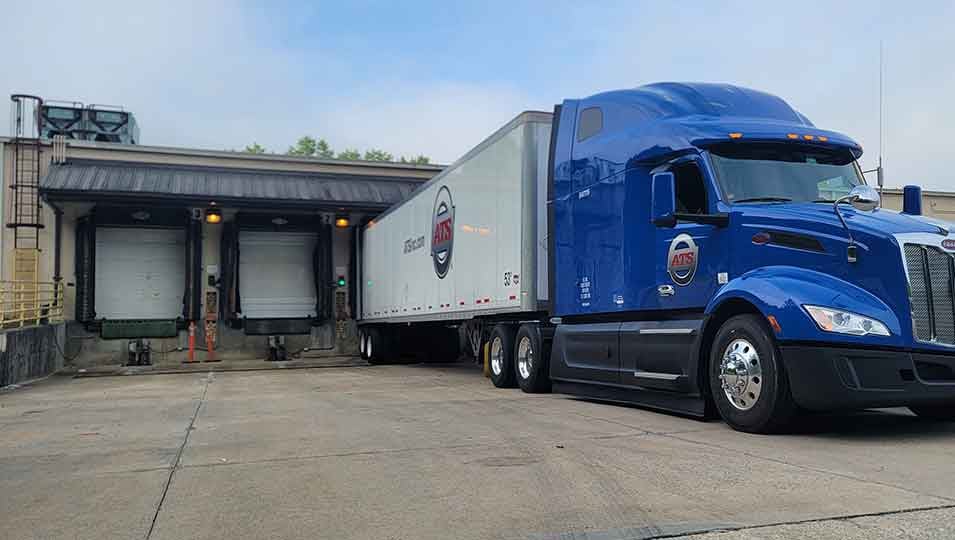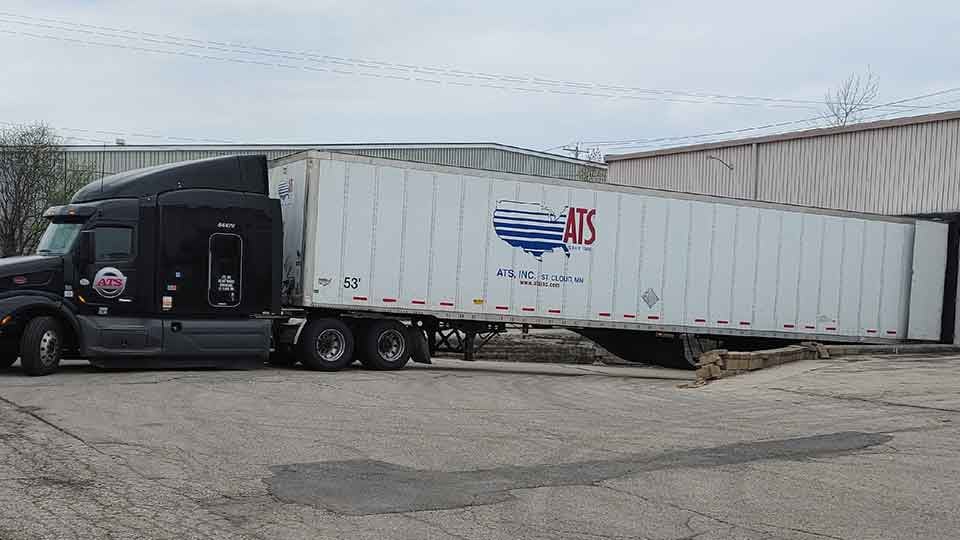When arranging a shipment, one of the first questions you may be asked is if a loading dock will be available at the origin and destination points. Including this information in your initial specifications can help determine how long it will take to load or unload the trailer and give the driver guidance on where to park.
What happens if you don’t have a loading dock? Are they required for all shipments? If you don’t have one, are you required to install one?
Don’t worry! At Anderson Trucking Service (ATS), we’ve picked up and delivered loads at all manner of loading docks, yards, warehouses, ports and everything in between. While we like to ask if a loading dock is present, our experienced team can work with you to arrange a pick-up or delivery in almost any circumstance.
Whether you send or receive dozens of shipments a day or just a few loads per month, there’s a solution that’s right for you. At the end of this article, you will understand what a loading dock is and how they are used, as well the advantages, disadvantages and alternatives.
What Is a Loading Dock?
Loading docks are large raised doors on the side of warehouses or manufacturing facilities that are designed for trucks to back up to so workers can quickly load and unload freight.
Most are about five feet off the ground, with doors 8-10 feet wide. These dimensions correspond with the measurements of dry van and reefer trucks, allowing drivers to back their trucks right up to the loading dock and open the door, then employees use forklifts, pallet jacks and other equipment to empty or fill the truck.
Loading docks can be built in two ways. One way is to lower the ground so the truck backs down a ramp before they meet the door. The other way is to build the warehouse so it’s about five feet higher than the surrounding ground so the truck backs across a flat surface.

What Are the Advantages of a Loading Dock?
Loading docks allow you to load and unload a truck faster and without specialty equipment. Drivers usually budget a certain amount of time to load or unload the truck; longer load time will lead to additional charges. Loading docks make it easy for the truck to back up, load/unload and drive off without dealing with ramps and equipment.
Another advantage of loading docks is that they keep the entire operation inside. Dock seals create an enclosure around the back of the truck to enclose the freight, equipment and workers moving in and out of the truck.
- Freight is never exposed to the elements outside.
- The warehouse door can be locked, protecting your cargo from potential thieves.
- The truck is loaded and unloaded in a controlled environment, keeping your staff dry and at a reasonable temperature.

Using a loading dock is also one of the safest ways to load and unload freight. Everything is done on a flat surface, without worry about weather. Freight and equipment uses one access point, giving your employees one way to look without worrying about potential hazards coming from all directions.
Busy retail facilities and large warehouses that receive multiple full truckloads per day will realize the most benefit from the speed and efficiency of a loading dock. Companies receiving fewer deliveries and pick-ups may prefer an alternate method to load and unload trucks.
What Are the Disadvantages of a Loading Dock?
The primary disadvantage is the cost. The initial cost of installation, including platforms and safety equipment, can run $50,000-$100,000. After the dock is in place, maintenance costs will vary based on the type of equipment and how heavily they are used but can cost several thousands of dollars per year.
Loading docks are also designed for enclosed trucks. Facilities that receive mostly flatbed shipments loaded from the side or above will not benefit from a loading dock.
Docks that angle down to the door can also collect rainwater or debris next to the building. This is usually only an aesthetic concern, but you may need to periodically sweep out that area.
Loading docks are not for everyone. Even if your company would benefit from a loading dock, the initial cost of the dock itself and the associated equipment may not be feasible — especially in a leased facility.
What Equipment Do Loading Docks Use?
In addition to an overhead door, most loading docks use several pieces of equipment for safety and convenience, including:
- Dock levelers are steel bridges between the floor of the warehouse and the floor of the truck. Dock levelers close the gap to prevent tripping or dropping items as they move between the warehouse and the truck. Some levelers are simple sheets of non-slip steel, while some use hydraulic lifts to automatically compensate as the level of the truck adjusts based on how full it is.
- Bumpers are rubber barriers surrounding the outside door of the loading dock. Bumpers soften the impact between the truck and the building and prevent damage to both.
- Dock lights provide lighting in and around the truck for safety and convenience. Dock lights protect both the people loading the truck and pedestrians working in the warehouse.
- Trailer restraints or wheel chocks hold the truck in place to prevent it from moving while people are moving in and out.
- Dock seals and shelters enclose the truck and keep weather and pests from getting in during the loading process.
- Dock lips are barriers that automatically raise when there is no truck at the dock and lower when a truck is in place. This barrier stops forklifts and pedestrians from going over the edge of the dock when no truck is present.
No matter what equipment is used at your dock, safety should be the first priority. Consider adding floor tape, striping and other safety tools inside the warehouse to mark loading and unloading areas. While not technically loading dock equipment, safety measures like this are important to the health and wellbeing of your staff.
Understanding loading docks is the first step in determining how you will process freight at your facility. The next step is to consider the alternatives.
What Are Alternatives to Using a Loading Dock?
Not all businesses need or want a loading dock. Fortunately, there are alternate ways to load and unload freight onsite. If you are building or leasing a manufacturing facility or warehouse, consider how many shipments you expect to send or receive per day as well as the alternatives when deciding if you need a loading dock.
Ramps
The most common alternative to loading docks are ramps. There are many options to purchase portable ramps rated to the weight of fully loaded equipment. Ramps hook into the back of the truck to stay in place during use.
Unlike loading docks, ramps work with any type of vehicle, including flatbeds. Running about $20,000 for a complete set, ramps are a more cost-effective solution for facilities that do not have a loading dock. Companies with a large staging area may even be able to use multiple ramps to offload several trucks at once.
Loading with a ramp takes slightly more time than using a loading dock. The ramps need to be moved, set up and taken down every time.
Ramps that tilt at a sharp angle will also create challenges for driving equipment, which will enter and exit the truck at an angle rather than the flat surface created by a loading dock. Most ramps have a level platform to mitigate that problem; before purchasing a ramp be sure it is configured to meet your needs.
Scissor Lifts or Liftgates
Liftgates or scissor lifts are another option to load and unload trucks. Scissor lifts are platforms that rise to the level of the truck for loading/unloading. Liftgates are attached to the truck to raise and lower as needed.
It is a slow process to repeat this (raising and lowering) cycle every time the platform is loaded, so loading a truck via a scissor lift is more practical for LTL freight or other small shipments.
If using a scissor lift to load or unload an entire truckload, plan to pay for a longer delivery window. Drivers typically plan two hours onsite to empty or fill the truck; going over that time will mean additional charges.
Forking to the Truck
Another time-consuming alternative is to raise and lower a forklift to the level of the truck multiple times. A pallet jack or dolly cart inside the truck can then be used to arrange the pallets inside the trailer.
Both scissor lifts and forklifts are best used for loading or unloading a small amount of freight. If loading or unloading a trailer fully using one of these methods, plan for at least an additional hour to complete the shipment. If you regularly work with full truckloads, a loading dock or ramp will save significant time (which is money in transportation, and probably in your industry too).
Do You Need a Loading Dock?
Before building, purchasing or leasing a warehouse or manufacturing facility, consider how frequently you expect to load or unload full trailers of freight. Understanding how loading docks are used, the advantages and disadvantages of using a dock and the available alternatives will help you determine how you will receive and process shipments.
When you arrange future shipments, clarify in the initial specification how the truck will be loaded and unloaded. This will help the carrier determine the time it will take at your facility and help you avoid add-on charges at the end.
No matter how you load and unload trucks, ATS is here for all your shipping needs.





